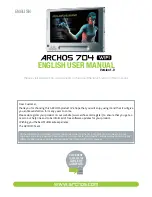
A.
Control Panel
NOTE: Total power drawn from all receptacles must not exceed
the nameplate ratings.
B.
120 V, 20 Ampere Duplex Receptacle
20 amps of current may be drawn from either of the duplex
receptacles. However, total power drawn must be kept within
nameplate ratings. These receptacles may be used along with the
twistlock receptacle provided the generator is not overloaded.
C.
120/240 V, 30 Ampere Twistlock Receptacle
Maximum full load current may be drawn from the 120/240 volt
receptacle, provided it is the only receptacle used. Total current must
be limited to the nameplate rating. If the 120/240 volt receptacle is
used along with the 120 volt receptacle, the total load drawn must not
exceed the nameplate ratings.
D.
Circuit Protectors
The receptacles are protected by an AC circuit protector. If the
generator is overloaded or an external short circuit occurs, the circuit
protector will trip. If this occurs, disconnect all electrical loads and
try to determine the cause of the problem before attempting to use the
generator again. If overloading causes the circuit protector to trip,
reduce the load.
NOTE: Continuous tripping of the circuit
protector may cause damage to generator or equipment.
The
circuit protector may be reset by pushing the button of the protector.
E.
Engine On/Off Switch
F.
Battery Charger
NOT RECOMMENDED FOR USE WITH GEL PACK,
SEALED OR SMALL (MOTORCYCLE) BATTERIES.
This generator contains an additional circuit used for battery
charging purposes. A DC accessory receptacle is provided on the
control panel. A battery charging cable equipped with a matching
plug for this receptacle has been supplied with the unit. Line up
metal prongs on plug with arrows on receptacle to secure.
The battery charger on this generator is referred to as an
unregulated taper charger - the most widely used in the market today.
The amount of current flowing will depend on the charging voltage
and battery's state of charge. As the battery becomes more fully
charged, the output current to the battery decreases and nearly
becomes constant. Taper chargers are intended to be used with the
provision that they will be disconnected from the battery after a
maximum time on charge. Normally a period of 30 to 120 minutes is
sufficient to recharge a weak battery. The charge level of the battery
should be checked periodically.
CAUTION: This battery charging system is
intended to recharge weak batteries, not to "boost
start" vehicles. Do not overcharge battery or leave
battery unattended.
Note:
When the battery charger circuit is in use, the AC
capacity is reduced by 96 watts. Make sure the combined load is
within the rated limits.
Before charging a storage battery, check the electrolyte fluid
level in all the cells. Add distilled water to each cell, if necessary, to
bring the level back up to the manufacturer's required level.
WARNING: Storage batteries give off
EXPLOSIVE hydrogen gas while charging. Do not
allow smoking, open flames, sparks, or spark
producing equipment in the area while charging.
Use cables approved for battery charging. Connect a red clip to
the positive terminal of the battery. Connect a black clip to the
negative terminal of the battery. Connect the other end of the cable
to the DC accessory receptacle on the generator panel. After the
battery is fully charged, remove the battery charging cable from the
generator and then disconnect from the battery posts.
WARNING: Battery electrolyte fluid is comprised
of sulfuric acid that can be very dangerous and
cause severe burns. Do not allow this fluid to
contact eyes, skin, clothing, etc. If contact or
spillage does occur, flush the area with water
immediately.
WARNING: Do not continue to charge a
battery that becomes hot or is fully charged.
DC CIRCUIT PROTECTOR
: The maximum current available
from the battery charger circuit is 8 amps. An automatic DC circuit
protector has been provided to protect the circuit from overloads and
assure that the battery gets recharged. If an overload occurs, the
circuit protector will trip. After it cools, it will automatically reset
itself. The battery's maximum rate of charge will eventually reduce
to less than 8 amps and then to zero as the battery approaches a 100
percent state of charge.
Charging a large capacity battery or a totally discharged battery
may cause the DC breaker to turn off. In these cases, a separate
battery charger unit connected to an AC power source is
recommended instead of the DC receptacle on the generator.
G.
Oil Warning Light
H.
12 HP OHV Engine
I.
Recoil Starter
J.
Engine Choke Lever
K.
Oil Filler Cap
L.
Oil Drain Plug
M. 5.8 Gallon Metal Fuel Tank
N.
Fuel Tank Cap
O.
Fuel Gauge
P.
Fuel Shut-Off
Q.
Hour meter
7
English
Customer Hotline 1-800-445-1805
GENERATOR FEATURES
A
B
F
E
D
N
G
C
I
K
L
M
H
J
O
P
Q








































